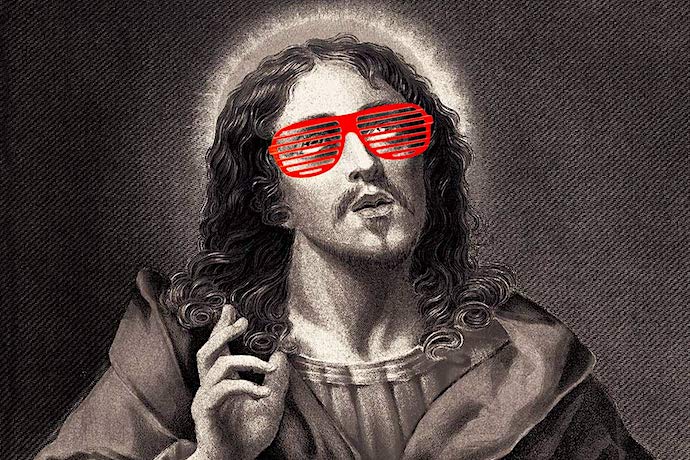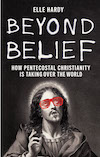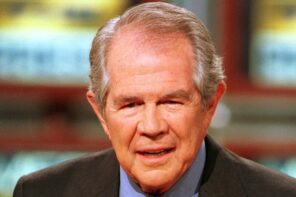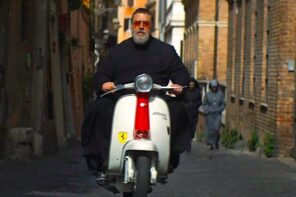Australian-born journalist Elle Hardy’s exposé of global Pentecostalism, released in November by an independent UK publisher, didn’t receive a tremendous amount of attention in the United States—one of the nations where the movement itself has flourished.
In the following Q&A Hardy and RD’s Katherine Stewart discuss the origins and different “waves” of Pentecostalism, the significance of “Spiritual Warfare,” and more. – eds
###
How did you first become interested in reporting on the rise of Pentecostalism?
My interest came about entirely by accident. A few years ago, I stumbled on the “John school” movement—faith-based remedial programs for guys caught soliciting prostitutes.
This phenomenon had not been widely reported at the time, so a few months later I traveled to Waco, Texas to profile one such program that agreed to host me. After a few days they revealed that they were inspired to found the school by Christine Caine, an Australian Hillsong Church alumna who grew up in Sydney like me. After Waco, I traveled to Mississippi to see Caine’s traveling roadshow, Propel Women Activate, a Bible-study-meets-self-help-seminar for busy moms.In the course of researching both stories, I began learning about the scale and scope of the Pentecostal/Charismatic/Spirit-led movements. I read the work of other scholars and writers, most notably Richard Flory and Brad Christerson’s book, The Rise of Network Christianity.
A massive story is taking place largely under the radar. Some brilliant academics and journalists are reporting on the Pentecostal revolution, but their work is not as broadly appreciated as it deserves to be. How many people know that Catholics are no longer the majority in Brazil; that North Korean defectors are turning to Pentecostalism as they adjust to life in the South; and that Romani and Gypsy populations across the UK and Europe are rapidly converting to this form of the faith?
I’m attracted to big, global stories and wanted to tackle the topic in a way that’s fun and engaging.
Tell us a little about the origin story of the Pentecostal movement and William J. Seymour, and the ideas and events that shaped his work.
I think it’s instructive that Seymour—the son of emancipated slaves from Louisiana—is widely considered the founder of the movement, rather than his (white) mentor, Charles Fox Parham, who I think has a better claim. While this is largely for historical reasons—Seymour had a much larger audience in Los Angeles, and news of the revival was reported in the city’s press the same day as the San Francisco earthquake—it also speaks to the fact that, from the beginning, Pentecostalism has appealed to minorities, migrants, the downtrodden.
William J. Seymour was born in Louisiana in 1870 and grew up in African-American Catholicism steeped in strong elements of the supernatural. In 1895, he fled the poverty of subsistence farming and racial persecution.
In his travels through the Midwest, he was born again into the Methodist faith and introduced to the Holiness movement, a forerunner of Pentecostalism. But it was an outbreak of smallpox, which cost him an eye, that changed his life—he thought God was punishing him for being too slow to answer the call to the ministry.
Seymour studied under Parham in Houston in 1905. Jim Crow laws meant he had to take his instruction from outside the classroom. Parham was horribly racist, with a quick temper. Seymour, on the other hand, has been described as kind and considerate. In spite of their differences, Seymour and Parham began street-preaching together.
Though his character was temperate, Seymour’s theology had a hellfire streak. Many people really thought that the earthquake meant the End Times were almost here and it was time for them to spread out around the world and save not just souls but entire nations.
Many people are broadly aware of the rise of Pentecostalism, yet know so little of its origins.
While writing the book, I went to Los Angeles a couple of times and stayed downtown right near Azusa Street, which is considered the birthplace of the movement. Twice a day, I’d walk by the little plaque that marks the spot where the spirit allegedly came to William J. Seymour and his congregation in 1906.
Part of me was wondering if some divine inspiration might come my way, but mostly I was hoping to find an interesting pilgrim to speak to. Not once did I find another soul pausing to see this historical landmark. I even interviewed a very pious young Latina woman from a Pentecostal congregation not a mile from Azusa Street. I asked her about Seymour—she said: “Who?”
That’s fascinating. The movement’s origins aren’t important to most Pentecostals I encountered, but I suppose that shouldn’t be surprising. One of the most common themes of my book is that Pentecostals (and I use that as a catch-all term to include charismatics and the “Spirit-led” nondenominationals) speak to the here-and-now. As someone said to me in Brazil, “The difference between Pentecostalism and Catholicism is that Pentecostalism says that you can be happy in this life.”
Is Pentecostalism substantively unique in its activism and organization?
I don’t need to tell you that evangelicals have long been really good at organizing politically, but Pentecostals have changed the emphasis. John Wimber, a key figure in the ‘60s and ‘70s, pioneered what’s called ‘power evangelism’—or as he called it, “Doin’ the stuff.” It’s all about direct participation in the miraculous—Christianity ‘on demand,’ if you will.
For example, in Redding, California, you get groups from the Bethel Church barging into emergency rooms to lay hands on the sick. The church recruits charismatic ER doctors and healthcare workers to their town.
Traditional evangelical networks have tended to organize within formal political—or at least politically adjacent—structures, such as the Family Research Council. Pentecostals might get involved with such groups too, but they’re also out there doing their own thing. They take the view that we’re in God’s advancing kingdom—go out there and do whatever you can. Prayer walk through the red-light district to cast out the demons; stop that woman in her wheelchair and command her to be healed in Jesus’ name.
There’s also a spirit of innovation at play. Leaders of many modern Pentecostal churches see themselves as ‘brands,’ and they’re looking at new ideas and product differentiation. So they’re meeting up with like-minded people from around the world and seeing how they do church, how they do political organizing, and swapping ideas.
How do you distinguish Pentecostals from charismatic Christians?
Charismatics are what’s referred to as the second wave of Pentecostalism, which got its start in 1960s California. It’s Spirit-led, personalized, and focused on power evangelism—that is, performing miracles and providing signs and wonders, as they see it, through the Holy Spirit’s ability to manifest success in the mind, body, spirit, and wallet.
Pentecostalism is quick to look more like the world it’s in. In 1960s California, it offered hippie spiritual experiences through the Jesus People movement.
These ideas spread quickly into Catholic Latin America. Rome was losing its congregants to Pentecostal churches—Pope John Paul II called Pentecostals “ravenous wolves”—and had to adapt. The charismatic Catholic Renewal was created to accommodate a Spirit-led practice, where you could keep the Virgin Mary and the Saints you grew up with. But these churches have much in common with, and are greatly influenced by, the Pentecostal movement.
By the 1980s, a third wave, called the neo-charismatic movement, brought together all of the ideas of the first two waves and doubled down on experiences with the miraculous. Structurally, they were becoming really good at digital and other media (think Hillsong’s music), and evolving into global, corporate brands.
How does Pentecostalism relate to the political cultures of some of the countries in which it is most prevalent?
Pentecostalism has become extremely influential, not just in America but around the world. I want to point to two modern doctrines that are entwined with Pentecostalism and that are both highly politically charged and quite troubling.
First, there’s the Seven Mountain Mandate, or 7M—the idea that right-thinking Christians are to take over the seven mountains or “spheres of influence” of culture and society. This includes education, religion, family, business, government, arts and entertainment, and media. The ideology draws from Pentecostalism and Christian Reconstructionism, among other strands. It is repackaged Christian Dominionism for the 21st century, and it’s fortifying the radical right of U.S. politics.
The second doctrine is Spiritual Warfare, and it’s hugely influential, particularly in the global south. It’s changed politics around the world. In Nigeria, for instance, it has significant political sway. In order to get the support of powerful preachers, political figures (even Muslims) have accepted that the world is defined as a spiritual battle between good and evil.
How is the Pentecostal idea of spiritual battle substantially unique?
This kind of demonology allows people to merge traditional cultural beliefs with evangelicalism. This is particularly prevalent in sub-Saharan Africa, Asia and Latin America, but also in the West too.
Spiritual Warfare isn’t simply about the salvation of individuals; there’s a belief that evil spirits operate ‘strategically,’ i.e. in geographical areas and institutions. So people who advocate these types of ideas might say that the Las Vegas strip or the Democratic Party or their local school board has been taken over by evil spirits.
I can’t emphasize enough how rapidly the idea of Spiritual Warfare is growing. Trump’s spiritual advisor, Paula White Cain, was mocked for asking for termination of ‘all Satanic pregnancies’ in the 2020 election. People thought she was mad. No, she was speaking to a huge audience, both in America and overseas!
What are some popular misconceptions about Pentecostalism and its relationship to evangelicalism in America?
Many (though not all) Pentecostal churches in the U.S. and Europe stand out in particular for their racial diversity. Walk into any Hillsong in the West, for example, and the congregation will be young, exuberant, and majority non-white.
Tell us a little bit about how Pentecostalism spreads through entrepreneurial leaders and parachurch networks.
Charismatic leaders are a lot like Silicon Valley entrepreneurs in that they’re keenly aware that they’re operating in a marketplace of ideas. They’re big on ‘disruption’—making faith accessible and convenient. This might mean opening church at 5 a.m. so people can attend a service before work (as in Universal Church of the Kingdom of God in Brazil), or streaming a 24-hour worship chapel online (International House of Prayer Kansas City).
In time, I think the pandemic will prove significant in changing the way people attend church. More and more, people are following pastors they find on social media who align with their particular interests and have good digital infrastructure.
As for the networks, Flory and Christerson have done great work in this area. There’s been a real exodus from denominations such as Assemblies of God in favor of informal cooperation networks, where different prophets and apostles are appearing on one another’s Facebook shows, speaking at conferences, cross-promoting books and so on.
They recognize that a rising tide lifts all boats, but they’re also focused on maintaining their personal brand. After all, these days they’re not competing with the preacher down the road, they’re competing with preachers from all over the world on the YouTube sidebar.






